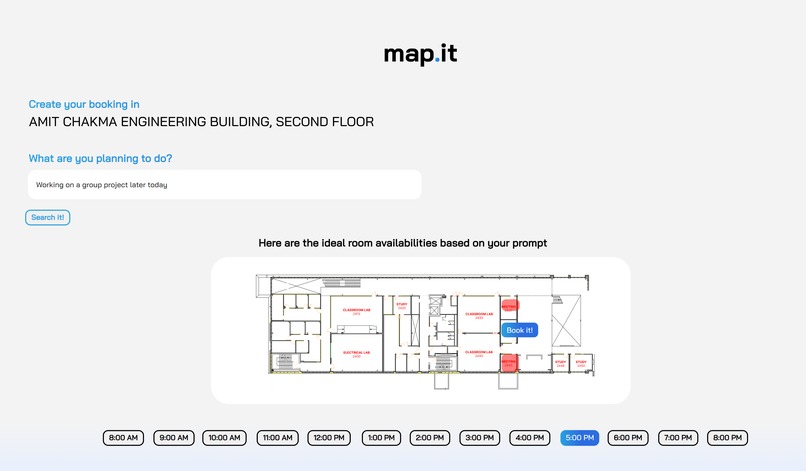
Picture this: you have deadlines fast approaching with things to do and people to meet, and on top of it all, you have to figure out where you’re going to work.
Current digital booking systems make this a pain! You seldom know what rooms are available to you and where, and you often struggle to have all availability information at your fingertips. Don’t you wish you could see booking information? Well fret no more.
map.it is your one-stop shop for all your room-booking needs. It’s an intuitive and accessible web application that works by showing you a visual floor plan of the building you wish to book a room in. The best part is that you don’t even need to read the floor plan to figure out which room to book; simply type in what you need a booking for, and map.it will intelligently determine your best booking options from the rooms scanned on the floor plan.
From there, you get a glanceable view of all the room statuses pertaining to your needs throughout the day (red for occupied, green for available). Simply click on any available room and confirm to complete your room booking.

At the heart of map.it is the Cohere classification API, which takes as input a set of training examples categorizing when you might want to book the room (morning, afternoon, and evening), what kind of space you’re looking for–whether it’s a classroom space, a meeting room, or simply a study space to focus in–and the duration of your booking. The highest confidence scores for each sub-category are captured in a Node endpoint, which the front-end React web application hooks up to in order to filter the spaces and times accordingly.
The Google Cloud Platform is also heavily leveraged; the Vision API is used to extract the labeled room numbers from the map and corresponding coordinates of the label bounding boxes used to create the overlaying clickable areas of the map. Google Storage is used to store a reference to the map passed into the Vision API. Lastly, Google Firestore enables the storing of room availabilities for each time of the day, which the web application reads and writes to.
Having experienced the grievances of confusing booking systems, I’m proud to have contributed to a platform that meaningfully enhances the utility of something that is instrumental to our daily lives. As we leave behind the era of online schooling, shared spaces on university campuses are needed more than ever before to support continued learning and sustain community growth. At the same time, hybrid working models have popularized immensely, and many institutions are adapting by shrinking their needlessly large workspaces. As such, a technology like map.it could help facilitate a navigable, frictionless shared workspace model.
map.it is also the winner of Best Use of Google Cloud, Presented by MLH at Hack Western 9!
There are many avenues for feature expansion that map.it could take outside of the tight 36-hour hackathon timeframe. For one, we could implement functional administrative features that allow institutions to upload their building’s floor plans and generate shareable links for their constituents to use and start booking rooms. Furthermore, integration with popular online calendar tools would allow users to seamlessly integrate map.it’s booking abilities into their digital schedules and create prompts based around their currently-scheduled events.